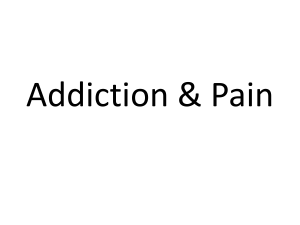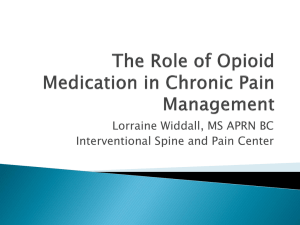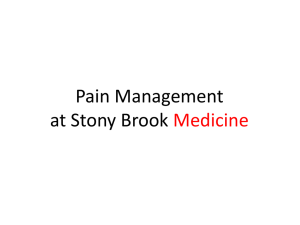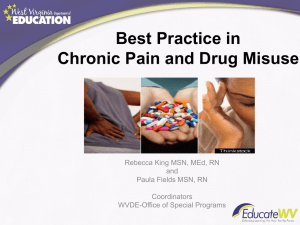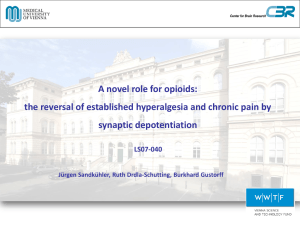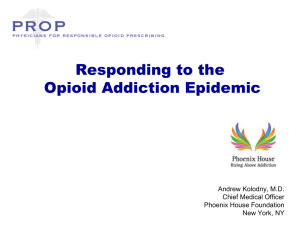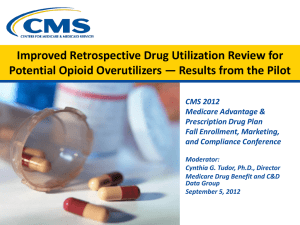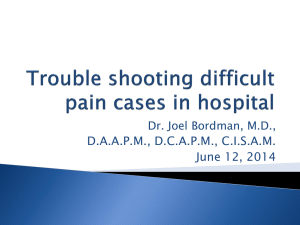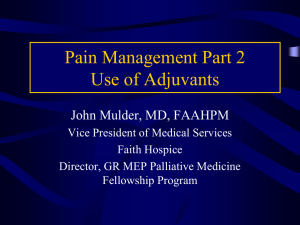Cochran 2014
advertisement
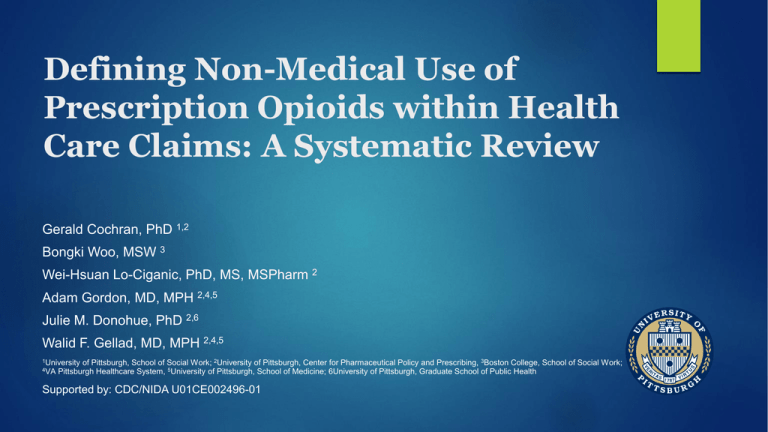
Defining Non-Medical Use of Prescription Opioids within Health Care Claims: A Systematic Review Gerald Cochran, PhD 1,2 Bongki Woo, MSW 3 Wei-Hsuan Lo-Ciganic, PhD, MS, MSPharm 2 Adam Gordon, MD, MPH 2,4,5 Julie M. Donohue, PhD 2,6 Walid F. Gellad, MD, MPH 2,4,5 1University 4VA of Pittsburgh, School of Social Work; 2University of Pittsburgh, Center for Pharmaceutical Policy and Prescribing, 3Boston College, School of Social Work; Pittsburgh Healthcare System, 5University of Pittsburgh, School of Medicine; 6University of Pittsburgh, Graduate School of Public Health Supported by: CDC/NIDA U01CE002496-01 4.9 Million People Misusing Opioid Medications: A Critical Public Health Issue Increased Physical, Mental and Behavioral Health Issues 50 deaths/day (2010) Societal cost of $55.7 billion (2007) Health System, Payer Data could Flag Non-Medical Use of Prescription Opioids (NMPO) for Timely Intervention To Date, NMPO Definitions Remain Unclear Purpose Systematic Review of Publications that Define & Measure NMPO Objectives: Describe definitions of NMPO Identify areas for improvement Search Yielded 2,613 Studies 8 Databases 2000-2014 Medicine: CINAHL, Health Source: Nursing/Academic, Medline, PubMed Psychology: PsychINFO, PsycArticles Social Work: Social Work Abstracts Public Affairs: PAIS International Related Terms in 3 Broad Categories (Boolean AND/OR Queries) Opioids Health Insurance Claims Non-Medical Use/Dependence Search strings/commanda Opioid category AB/TI (Analges* OR Buprenorphine OR Fentanyl OR Hydromorphone OR Morphine OR Opi* OR Oxycodone OR Oxymorphone OR Oxycontin OR Painkiller OR Pain Management OR Pain Medication OR Suboxone OR Subtex) AND Health (Admin* OR Benefi* OR Claim* OR Diversion* OR Enrollee OR Insur* OR Medicaid OR insurance Medicare OR Pay*) claims category AND Non-medical use category a (Abuse OR Chronic OR Dependence OR Long-term OR Misuse OR Overuse) Terms related to opioid medications were searched using the electronic database search engines within the title and abstract, and terms related to claims and misuse were searched using the electronic database search engines from any part of the article. This decision was based on very limited search results generated when all terms were only searched within titles and abstracts. * = Exploded mesh term encompassing all MeSH subheadings. The Study Selection Process Consort flow diagram of selected studies - - - - - - - Key Data Points Extracted General: Author, Date, Source NMPO Conceptualization: the Name of the Problem Abuse? Misuse? Probable misuse? Rx mentioned? NMPO Operationalization: Measurement Variables Dosage? Diagnosis? Prescriptions filled? Number of providers? Validation Methods Purpose of Analysis Rates of NMPO Results Data from Publicly Funded Sources N=2; Commercial N=3; Both N=2 NMPO Conceptual Definitions Identifying prescription opioid abusers n=3 Potential or probable misuse of opioid medications n=3 Persons who chronically misuse opioids and are non-adherent to prescribed regimen n=1 4 General Types of Operational Definitions w/ Varied Combinations ICD-9 diagnosis codes Opioid prescription records Provider/pharmacist records Urine toxicology Results Operationalization of NMPO First author/ year Diagnosis-based measure Stated NMPO concept Number of providers and pharmacies Braker 2009 Potential Rxbopioid misuse -- Leider 2011 Non-adherence among chronic opioid users Potential opioid misuse/ inappropriate Rx practices -- Rice 2012 Rx opioid abuse Roland 2013 Diagnosed Rx opioid abuse Sullivan 2010 Probable opioid misuse among chronic opioid users 304.0X (opioid-dependence), 304.7 X (combinations of opioid-type de pendence with any other drug depe ndence), 305.5X (nondependent opi oid abuse), and 965.0 (poisoning by opiates/related narcotics) 304.0X, 304.7X, 305.5X, 965.00, 96 -5.02 (methadone poisoning), and 9 65.09 (opiates poisoning not elsewh ere classified) Number of prescribers (≤2, 3-4, ≥5); number of pharmacies (≤ 2, 3-4, ≥5) White 2009 Rx opioid abuse Logan 2013 -- 304.0, 304.7, 305.5, or 965.0 Prescription-fill based measure Urine toxicology Received ≥3 opioid Rxs from Yes/no record of opioid Rx ≥2 providers; ≥6 opioid Rxs w ithin 6-months 120 days of a qualifying opioid -within 6-months Opioid Rxs overlapping ≥1 -week; overlapping opioid and be nzodiazepine Rxs; long-acting/ extended- release opioids for acute pain; or ≥100 morphine mi lligram equivalent/ day -Yes/no record of opioid Rx -- -- -- -- Medication match and levels within expected ranges -- -- > 90 days of opioid use; days of -short acting opioids (≤185, 186-2 40, >240) and days of long actin g opioids (≤185, 186-240, >240) within 6-months Yes/no record of opioid Rx -- Validity Tests: Varied as Well Quantitative Braker: adequate validity predicting >6 Rxs filled in 6 months Sullivan: OUD diagnosis + NMPO outcome showed adequate validity White: validity with integrated prescription + diagnosis variables Qualitative Leider, Rice, Logan Based on face and content validity Rational justification for definitions Citations of previous work Rates of NMPO: Varied From 0.75% to 10.32% Cause of differences: Definitions Cutoff points Equations Examples: (a) Likely non-adherent patients Total chronic users (b) Patients with 1 inappropriate prescription factor Patients w/prescription from ED (c) “Abusers” Total sample Conclusion and Recommendation There is a Need to Identify and Intervene in NMPO Current Knowledge is Inadequate Both conceptual and operational definitions vary among studies Existing definitions and measures have not been convincingly validated A Prospective Study Would Yield Valuable Data Recruit subjects through health plans Assess for NMPO Validate measures with existing validated measures Thank you gcochran@pitt.edu
